Florida has long worn its warmth as a badge of identity. But the climate of our identity is changing: it isn’t just hotter — it stays hot. New science shows moisture in the atmosphere slows nighttime cooling, turning what used to be a relief into an all-night health threat in our coastal and urban neighborhoods. For people who sleep outdoors, work outdoors, or live in housing without reliable air conditioning, that extra degree — maintained through the night — can be the difference between a long, exhausting season and a life-threatening one. (The Salata Institute)
The human consequences are already visible in Florida. Heat harms productivity, strains public health systems, and disproportionately affects outdoor workers — construction crews, landscapers, agricultural laborers, delivery drivers — many of whom are low-income and have limited access to cooling or paid sick leave. The economic cost of heat on labor is massive and rising; productivity losses at certain temperature thresholds are well documented. Yet statewide legal protections for outdoor workers are limited, leaving employers and localities to pick up the slack.
This is an adaptation problem with a clear portfolio of practical solutions — and a clear equity imperative. Cities and counties can combine near-term life-saving fixes (paid rest breaks, shaded rest stations, cooling shelters, emergency heat-response protocols) with medium-term design investments (expanded urban tree canopy, reflective surfaces, permeable pavements, and strategic water features). Employers and school districts can update schedules and policies to avoid peak-strain hours, retrofit HVAC in vulnerable school buildings, and fund on-site shade and hydration for outdoor crews. Research shows targeting the hottest neighborhoods first — where tree cover is lowest and pavement density highest — yields the biggest public-health wins per dollar. (The Invading Sea)
Florida’s unique climate — high humidity plus urban density — means some classic heat-adaptation playbooks must be rethought. Nighttime cooling strategies (green roofs that cool overnight, improved building envelopes that slow heat storage, community cooling hubs with reliable backup power) become especially important when the usual “nighttime reset” no longer happens. And because heat risk maps change as neighborhoods densify and tree cover is lost, planning must be repeated, not one-and-done.
At the Climate Adaptation Center, we see many interventions are low cost and fast to scale — shaded bus stops, employer heat-standards, municipal incentives for tree planting, and school retrofit grants. The harder work is political: aligning state policy, employer incentives, and municipal finance so those who are most exposed aren’t left behind.
Join us at the 5th Annual Florida Climate Forecast Conference: Climate & Biodiversity—learn what’s working, meet the people doing it, and see solutions your community can use now.

